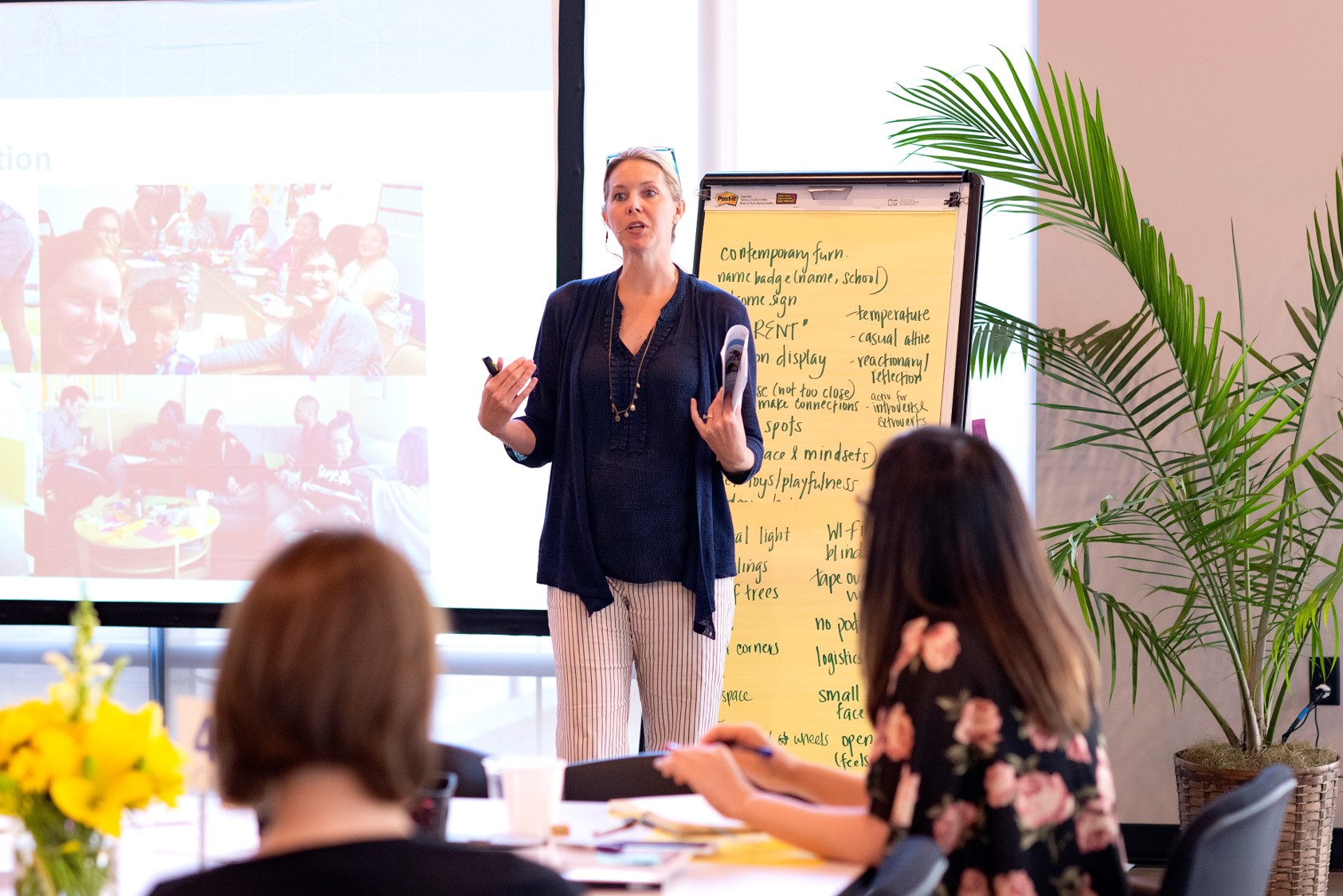

Design thinking helps you create better products, services and outcomes by solving problems with end-users in mind. It’s more than simple brainstorming, so what basics do you need to know? Faculty design thinking experts from UNC-Chapel Hill offer practical advice to get you started.

Innovate Carolina talked with two of our design thinking experts to explore the phases of this problem-solving method: Melissa Carrier, a professor of the practice the Department of Public Policy and director of social innovation with Innovate Carolina; and Liz Chen, assistant professor at the Gillings School of Global Public Health and Innovate Carolina’s design thinking lead. Melissa and Liz provide design thinking workshops and consults to Carolina faculty and startups, plus organizations outside the University via Innovate Carolina’s innovation services hub.
In a three-part series, we explore key phases of design thinking: Inspiration, Ideation and Implementation. This week, we look at Ideation.
Liz: People often associate ideation as free-for-all brainstorming, and that’s definitely part of it, but there are also really deliberate conversations and decision-making processes within ideation. Often, we ask groups to brainstorm and come to a consensus, all in one place and during one time period. But that doesn’t usually result in the testing of multiple ideas. So, we really encourage people to individually brainstorm in addition to group brainstorming. We also encourage including a separate round to come up with criteria by which to evaluate the choices, and to then pick the ones to move forward with.
Melissa: I think of the ideation phase very similarly. It’s about sparking as many ideas as possible, and often we do that in the form of solutions. But we also want that large number of ideas to be generated without any kind of constraint. Teams can then select the most practical or impactful ideas to pursue, so it is definitely a two-part process. The other thing I would add is that ideation is really intended, within the three-phases of design thinking, to draw upon the creative energy of your design team and to give stakeholders the opportunity to develop concepts that might not have been imagined with traditional problem-solving approaches. In this case, we’re really asking questions that create variety and quantity rather than limitations we impose with constraints in a typical strategy or product development effort. So, the aim of ideation is to move beyond those really obvious solutions to something much more interesting and unexpected.


Melissa: Most people think of brainstorming as synonymous with ideation, and the fact is that it is so much more dynamic than a set of Post-it notes and markers. We start with the idea of going really wide, diverging on our thinking and then creating a bunch of choices to brainstorm. We can get an abundance of ideas, and then follow that with an effort to converge on the most desirable, feasible or viable ideas through some criteria that the team would define. As Liz stated, it is a very interesting process, and you don’t just do it once. You do it multiple times, and you’re always learning and building on ideas as you go.
Liz: With the brainstorming step, you are inviting stakeholders and individuals who are approximate to this particular challenge to do these activities with you. So, when we say brainstorm, it’s not just those on your isolated design team who should be brainstorming. Others, like the intended users, those who would pay for the service, or people who are related to all these stakeholders should also be at the table. That’s the implicit stuff that we make explicit the best we can. Another step is prototyping, which Melissa mentions. It’s not just coming up with ideas, but it’s also the initial phases of pitching those ideas – taking them from what’s in your head to making them real – so that other people can see and experience what you’re thinking. And then intentionally building prototypes or other representations of these products and services so that we can continue to get feedback and data as to whether they confirm the hypothesis or assumptions we have.
Melissa: The ideation phase really provides that stimulus or source of material for beginning to create prototypes and get solutions into the hands of people who are actually experiencing the challenge or the problem you’re trying to solve. From ideation, design teams use the techniques of early prototyping to figure out what works and what doesn’t work. They often will return to the early pieces of ideation for additional brainstorming, constantly building on that learning process. It’s not linear, and it’s very interactive. Ideation gives teams the space they need to find a solution that’s going to work best, and that’s the most impactful, non-obvious answer to the problem they’re trying to solve. Then, working backwards to inspiration, often – especially when you’re working with stakeholders in the creative process – ideation will garner new insights. You learn a lot more about how the problem is situated, and sometimes teams then return to inspiration, allowing them to redefine the problem or uncover a new aspect of the problem that then goes through another set of ideation work.
Liz: I, agree. The stimulus for ideation can inform additional inspiration activities that need to be completed.
Melissa: One technique is using trigger questions or unexpected prompts to generate really out-of-the-box ideas and thinking. For example, asking questions like ’What is the worst possible idea you could imagine?’, ’What is the most unattainable, extreme or impractical solution you can think of?’ or ’What if you only have one dollar to solve the problem?’ I’ve used many versions of this, and it helps teams brainstorm differently in how they come up with unique solutions.
Another effective method we use is called mashups. The idea is that you’re bringing unexpected things together to ignite fresh ideas. So you might think of two really broad categories, brainstorm them, and then look for ways to mash them together. This gives teams a great template for ideation to look at while they brainstorm. For example, one brainstorm category could be around elements of a hospital experience and then a second brainstorm could be around things you would find in a hotel. Then, a team would mash those together like… ’What if you’re in a hospital and they provided things like comfy robes and slippers? What if you had a coffee maker and bottled water in every room?’ I think mashups can be a fun way to enhance the brainstorming process at the front end of ideation when you’re really trying to create as many different kinds of ideas or non-obvious solutions as possible.


Liz: Where many of our students and faculty get stuck is that they’re very good at brainstorming, but then they get stuck on whittling down ideas or choices. I think we need to do a better job with coaching students and faculty to select criteria of decision making. So whether it is typical criteria like cost, development time, or desirability, there are other constraints and preferences that teams need to surface early. It shouldn’t be that those need to be predetermined prior to any decision making. Otherwise, you do tend to get the expected ideas.
Melissa: At the beginning of problem definition and framing of the challenge, you’re thinking about the boundaries of the criteria that will help you select concepts you want to take forward. It’s definitely the problem with Ideation – the way so many teams use it as one and done. It’s like ’We’re going to do a 90-minute brainstorm and come up with all these ideas. Then we’re going to vote for our favorite three and move forward.’ How do you make that selection? Is it a popular idea? Do you see where the boss put their blue sticker, so that’s where yours goes? There’s just a whole lot embedded in that process, so if teams can identify criteria up front or have discussions as they’re doing inspiration, it’s a nice way to continue to work in that fashion of brainstorming. You can start to make more decisions as you begin to slowly narrow down the concept.
Another a technique or method we have used is called create-a-concept. In this method, you go through the traditional brainstorming process, but maybe not through all the different aspects of the particular solution or problem. Then, you begin to create groups or bundle those ideas into themes. For example, in looking at ideas for a core structure for a course, what would the student experience look like? What are the ways in which we might do experiential learning versus more didactic learning? What is the right type of feedback system? When you use the create-a-concept method, you brainstorm some of these different pieces and pull each of the groups into a unique set of concepts. You might end up with a list of five or 10 concepts, so this method really helps you move from just a set of ideas to an interesting solution that you can then evaluate against other concepts that come from multiple brainstorming sessions.
Liz: Ideally, up to this point you’ve identified what a successful outcome would be for a particular project. You will have collected data along the way and the threshold metrics for each in order to push it forward as a viable idea for testing. So you get to the point where all indications are that this is successful, and you need to think about other aspects of the journey map. Minimalist journey mapping is another method. It’s important to think about how real people will come across or hear about this product or service. Then, after they try it, what do you expect them to do? And, how could they potentially turn into advocates for the product or service? So in theory, if you’ve been really intentional with thinking about the whole journey for the user and have set threshold metrics that need to be met to feel good about moving an idea forward, then you should be rather confident about these ideas that you move forward into launch.
Melissa: The reality is that, even though you start the ideation phase thinking that the sky’s the limit, you know the project is not without constraints. So, as you move into convergence and selection, you do have these really critical identifications of decision points or targets to help you make a decision about pieces of the project or how the solution moves forward. The other method to talk about is the customer journey, which helps you visualize the patterns and understand the perspectives of the people you’re designing for. I can help you identify places where your solution is working or not working. The beautiful thing about journey mapping is that it is an analytical tool, but it’s also a really visual one. If you can see what an end-user experiences, the solution or the intervention will connect to the emotional context instead of non-obvious things that are going along with that experience. We do think it’s a pretty powerful method to help you identify what’s working and not working.
Ready to incorporate design thinking into your work or research? For any questions on how to get started with design thinking, explore Innovate Carolina’s design thinking services or contact Liz Chen at Liz.Chen@unc.edu.